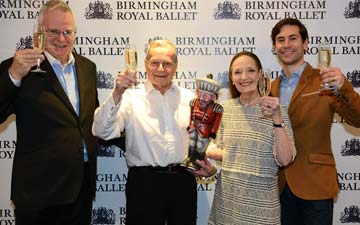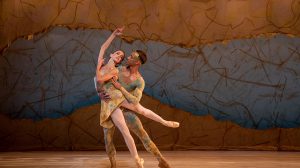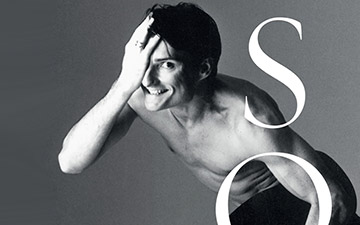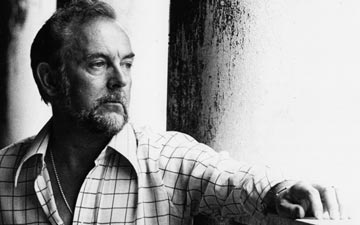
© Oberon Books. (Click image for larger version)
Peter Wright: Wrights and Wrongs – my life in dance
Peter Wright with Paul Arrowsmith
Oberon Books, www.oberonbooks.com
1 Jun. 2016
ISBN: 978-1783193462
Was Sir Peter Wright the best director the Royal Ballet never had? He poses the question teasingly towards the end of his book but leaves it to the reader to ponder – or decide. Wrights and Wrongs isn’t so much an autobiography as reminiscences of what he calls his ‘tangled career’ as a performer, ballet master, choreographer, TV director, second-in-command to artistic directors of ballet companies and then his own man, in charge of Birmingham Royal Ballet.
It’s a fascinating personal journey through the post-war history of (mainly) British ballet – all the more interesting if you’ve witnessed the performances and events he discusses. His is an insider’s account, complete with waspish comments and cameos of the famous people he encountered. The discursive book is organised by topics rather than chronologically, so there are inevitable overlaps and repetitions. Although Wright is candid in his opinions, he hasn’t been encouraged by his co-author to examine his experiences in any depth. Since anecdotes take precedence over analysis, and there are many inaccuracies, this is not a book for dance scholars. Ballet-lovers, however, will enjoy his perspective on what went on behind the scenes of public performances.
Wright credits his eclectic formation as a dancer as the making of him as a director and renowned stager of ballet ‘ classics’. His productions of Giselle, The Nutcracker, The Sleeping Beauty and Swan Lake have been in demand all over the ballet world. Yet he came to dance relatively late (at 16), starting his career as a naïf apprentice in the Ballets Jooss in 1943. By that stage, Kurt Jooss had based his modern-dance company in Cambridge. From there, his polyglot performers would tour war-devastated Europe.
Intrigued by ballet, Wright left Jooss in order to learn its academic technique from expert teachers – Vera Volkova, Lydia Kyasht, George Goncharov. He joined Victor Gsovsky’s Metropolitan Ballet and then the St James’s Ballet, before being accepted by De Valois’ junior company, the Sadler’s Wells Theatre Ballet, in 1949. His is an entertaining voice to add to records of the travails of touring companies in the post-war years. Feeling that he was getting nowhere after two years with SWTB, Wright rejoined Jooss’s company, now back in Germany. Young Pina Bausch was a member, and Wright has remained an admirer of her as a performer and choreographer ever since.
Back with SWTB after Jooss’s company went broke (like so many others), Wright reminisces about his relationship with De Valois over the decades – never easy, in spite of his profound respect for her. He leaps forward chronologically from being an unconsidered performer to taking charge of ballets, hers and others’. ‘If you wanted to make changes’, he writes, ‘you had to lead her to believe the changes were her own idea’. He had to calm her down on several occasions with the offer of a glass of wine in a pub – one of her poems is in praise of pubs.
Early in his career, Wright had started choreographing for operas and TV shows, sparking his interest in how to direct dance for cameras. He did a BBC training course for directors, and retails the trials and tribulations of live television (in black and white) as he worked with Maggie Dale and young Bob Lockyer. Wright reckons he might have changed course as a director of TV drama if John Cranko hadn’t invited him in 1961 to become ballet master of the Stuttgart Ballet.
That was to be his profession for the next five years, though he returned on occasion to TV as a guest producer. His Ballet Class (1964) and TV version of MacMillan’s Las Hermanas (1965) and Jooss’s The Green Table (1967), with Pina Bausch as the Old Woman, are still eminently viewable. Wright benefited from an era when people were exploring television as a medium, translating dance for the small screen. These days, as he says, ballet on TV is usually a live relay of an existing production, lost in the scheduling in a non-peak-viewing spot. He acknowledges, though, that the direction of cameras has become expert.
Wright credits Cranko with having a great influence over his future career. He had great affection and admiration for Cranko, while well aware of his promiscuity and overindulgence in drink. Wright often had to cover for him as his loyal assistant, a role he would later have to repeat with Kenneth MacMillan as director of the Royal Ballet. Cranko encouraged Wright to choreograph for the Stuttgart company, requiring him to complete parts of Onegin and Romeo and Juliet, as well as contributing his own creations, The Mirror Walkers and Namouna. Once Wright opted to leave Stuttgart, however, Cranko cooled towards him.

© Oberon Books. (Click image for larger version)
The decision to return to London in 1966 was for family reasons. Peter and his wife Sonya had two small children who needed to go to school in England. He therefore refused MacMillan’s request to join him as ballet master in West Berlin, where MacMillan was to be artistic director of the Deutsche Oper Ballet for the next three years. On visits to Berlin, Wright appreciated the difficulties MacMillan faced – but he had no foreknowledge of the problems to come when MacMillan took over from Frederick Ashton as director of the Royal Ballet in 1970.
The appointment was mishandled. Confusion reigned over job descriptions, as well as over the merger of the resident and touring companies. Wright was put in charge of the New Group of 20 dancers on tour, while MacMillan and John Field disputed their responsibilities as designated co-directors. After Field quit, Wright was made ‘administrator’, whereas in fact he was assistant director to MacMillan, dealing with the shambles the reorganisation had caused in human as well as admin. terms. He suffered from a gastric ulcer as a consequence.
It’s hard to credit that the Royal Ballet could have got itself into such an incompetent muddle by the start of the 1970s. Amalgamating two separate companies was never going to work, no matter who was in charge. Wright believes that MacMillan was better suited to being resident choreographer than artistic director: he was not equipped to deal with the internal politics of the Royal Opera House, nor with press and public relations. Wright had to deputise for him, on top of his own responsibilities for both companies.
Was he wrong, he asks, to dismantle the experimental New Group and revert to a more conventional touring company performing the ‘classics’ along with accessible one-act ballets? As the Royal Ballet’s history proves, a small offshoot of the resident company obliging the provinces with daring new works has never lasted long. Wright managed to secure more dancers, a wider repertoire and a resident base at Sadler’s Wells. He had John Auld as his invaluable assistant, while continuing to assist MacMillan with the Covent Garden company.
Wright transformed the touring troupe into a worthy rival of the main company. He took it to parts of the country that rarely or never saw ballet, thanks to seasons in the Big Top tent. He dispenses good advice in a chapter headed ‘Being a Director’: what sort of ballets to programme, whom to cast, how to develop promising dancers into ballerinas – above all, how to deputise while remaining in charge. He points out that he insisted his responsibilities were those of director, not simply artistic director under someone else’s management.
He was surprised and indignant at not being consulted over the appointment of MacMillan’s successor, Norman Morris, in 1977, nor over the choice of Ross Stretton to take over from Anthony Dowell. On both occasions, he states, he was told ‘We rather forgot to let you know’. Would he have accepted the post of artistic director of the Royal Ballet, had he been offered it? He believes that he was better off being in charge of what was to become the Birmingham Royal Ballet under his leadership. None the less, he lobs a grenade into the workings of the Royal Ballet, opining that, with the exception of Monica Mason, it hadn’t had a good director since its founder, Ninette de Valois.
Ashton was lazy, no good at administration; MacMillan was unsuited by temperament; Morris, an outsider, was an unfortunate choice; Dowell was too much an insider, incapable of dealing with the fall-out from the closure of the Opera House before the Millennium; Stretton was a disaster. Kevin O’Hare’s directorship has yet to be assessed, but Wright (who was involved in his selection) has faith in him. These are superficial judgements about many decades of the Royal Ballet’s history during which Wright was a key player – or perhaps he wasn’t, kept out of the inner machinations of decision-making by the ‘great and the good’ on the board of the Opera House, who underestimated him. Was he considered too loyal to those he assisted, not enough of a new broom? Yet, so far at least, radical choices of outsiders have hardly been successful.
Wright was nonetheless entrusted with the move of the ‘second’ company (a description he resented, while deploring the many names the touring company had been encumbered with over the years) to Birmingham in 1990. He gives a detailed account of why and how the Sadler’s Wells Royal Ballet became Birmingham’s flagship company, along with the Birmingham Symphony Orchestra. At last he was his own master, with his own board, eventually independent of the Royal Opera House. He would have remained BRB’s director for longer than five years had he not been struck down with a debilitating disease, myasthenia gravis. David Bintley took over in 1995 and is still director over 20 years later.
Once recovered from his long illness, Wright has continued to mount and revive his productions of the nineteenth century classics for many different companies. ‘I never thought my career would be defined by Giselle’, he writes, ‘nor want to be known just for The Nutcracker’. His book explains how he came to love and understand the dramatic logic of the old narrative ballets, as well as respecting the quality of dancing they require. His aim has always been to make sense of the scenarios for modern audiences, rather than treating them as illogical fairy tales. It’s an approach that didn’t appeal to American critics, such as Arlene Croce in The New Yorker, who objected to operatic productions of ballets with more emphasis on acting than on the execution of demanding choreography. Croce designated him Mr Wrong.
Elements of his innovations in Giselle were appropriated by other stagers of the ballet: Rudolf Nureyev and Natalia Makarova were so blatant in their borrowings that Wright threatened to sue. He admits, however, that he lifted his own ideas from his 1990 BRB Nutcracker in order to strengthen revivals of his earlier production for the Royal Ballet (1984), with its over-detailed designs by Julia Trevelyan Oman.
Wright has very decided opinions about appropriate designs for ballets and whether original décor and costumes should ever be redesigned. He deplores the RB’s attempt to return The Sleeping Beauty to Oliver Messel’s 1946 designs, on the grounds that tastes (and fabrics) have changed. Ballets shouldn’t remain museum pieces. On the other hand, he dislikes Deborah MacMillan’s alterations to Anastasia, The Prince of the Pagodas and Concerto. The choreographer’s and designer’s original choices were better.
The last sections of the book are devoted to descriptions of his productions and the people he has worked with – dancers, designers, conductors, back-stage staff, impresarios. Balletomanes will enjoy the anecdotes about famous and not-so-well-known figures, though the information isn’t revelatory. Nureyev could behave badly, as could Sylvie Guillem. Michael Somes could be a nightmare, Natalia Makarova, like Guillem, did as she saw fit. Lynn Seymour and Svetlana Beriosova, vulnerable in their private lives, made disastrous appearances on stage; Carlos Acosta was sensitive about revealing his buttocks when he turned his back. Wright has a soft spot for hard-working, biddable ballerinas, ranging from Margot Fonteyn to Darcey Bussell, Marion Tait and Miyako Yoshida (who contributes an appreciative forward to the book).
He is apprehensive about the future of classical ballet as a creative force, though confident that its technical training will survive even the most wilful acrobatics. He tries not to be too severe about modern works he dislikes, while deploring the appointment of Wayne McGregor as the Royal Ballet’s resident choreographer. ‘I really detect a minimal amount of choreographic imagination in terms of dance composition, musicality, variety, contrast and human expression in his work… a dangerous distortion of classical ballet’. Wright has hopes of Christopher Wheeldon, but worries that he and Liam Scarlett, as well as McGregor, are far from exclusive to the Royal Ballet: ‘The repertoire of companies world wide is becoming less distinctive, more homogenised.’
Now 90, Sir Peter Wright has plenty of wise advice to dispense. Let’s hope that those most in need of it will persist in reading his book to the very end. It can be indigestible, in need of diligent editing, but it’s full of gems that will appeal to any ballet lover. How about this one: ‘The public will clap at anything so long as ballerinas get their legs up and it all happens in the dark. Not that I am mentioning anybody in particular.’

















You must be logged in to post a comment.